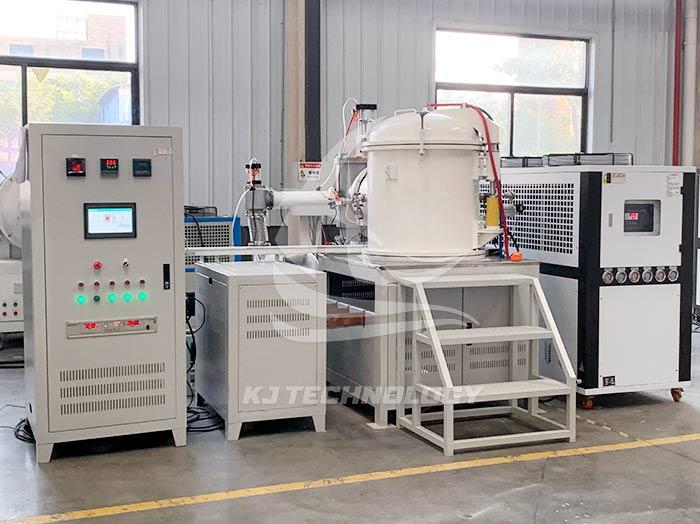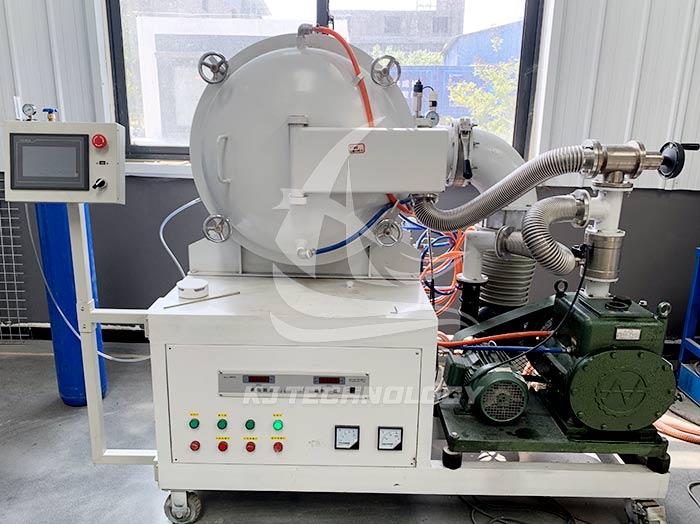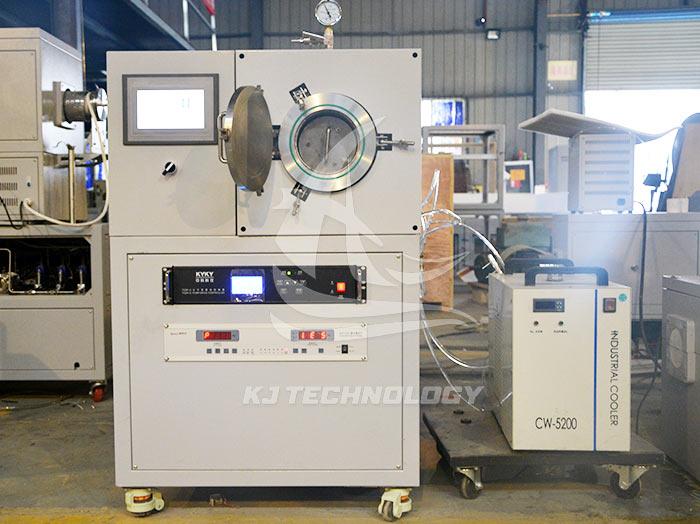High vacuum muffle furnace
 06-10-2025 Author: KJ technology
06-10-2025 Author: KJ technology
A high vacuum muffle furnace is a device used for heating in high-temperature vacuum or inert gas environments. The following introduces its characteristics, applications, advantages, and precautions for use:
Characteristic
High temperature performance: capable of reaching high temperatures (usually exceeding 1000 ℃), suitable for high-temperature synthesis and crystal growth. For example, some high vacuum muffle furnaces can reach a maximum temperature of 1700 ℃ or even 2500 ℃, which can meet many demanding experimental requirements for high temperature, such as sintering of special ceramic materials and high-temperature treatment of certain metals.
Vacuum and inert gas environment: can effectively prevent material oxidation or other unwanted chemical reactions. Equipped with vacuum function, material processing can be carried out under vacuum conditions, effectively avoiding material reactions with air at high temperatures, preventing oxidation, nitriding, etc., and obtaining products with higher purity and better performance.
Accurate temperature control: With a high-precision temperature control system, it ensures the accuracy of process parameters. Adopting advanced temperature control system, such as PID intelligent control algorithm combined with high-precision temperature sensors, the temperature control accuracy can reach ± 1 ℃, which can accurately control the temperature and ensure the stability and repeatability of the heat treatment process.
Multifunctionality: Can be used for various heat treatment processes such as calcination, annealing, sintering, crystal growth, etc.
Safety: Equipped with multiple safety protection devices to prevent accidental injury and equipment damage. If the side opening furnace door has a power-off function to prevent accidental heating when the furnace door is opened; The furnace body adopts a double-layer furnace shell structure, with insulation material filled in the middle to reduce the surface temperature of the furnace body and avoid accidental burns by operators.
Application
Material preparation: can be used to prepare various inorganic, organic, and composite materials. By controlling temperature and time, the synthesis, sintering, and melting processes of materials can be achieved.
Material characterization: Under high temperature conditions, the structure and properties of the material will undergo changes. After heat treatment using a high vacuum muffle furnace, the phase, morphology, and properties of the material can be characterized by various testing methods such as XRD, SEM, etc.
Thermal analysis: It can be used in conjunction with equipment such as thermogravimetric analyzer and differential thermal analyzer to study the thermal stability, thermal decomposition behavior, and thermal reaction kinetics of substances.
Ceramic products: They have a wide range of applications in the ceramic industry and can be used for processes such as sintering, melting, and glaze treatment of ceramic products.
In the field of metallurgy, metal ores can undergo processes such as reduction, smelting, and refining at high temperatures. The high vacuum muffle furnace provides a stable high-temperature environment for these processes, which helps to improve the yield and quality of metals.
New energy materials: With the continuous development of new energy technologies, high vacuum muffle furnaces play an increasingly important role in the preparation of new energy materials such as solar cells and lithium batteries.
New material research and development: When researchers study new materials, they need to use a high vacuum muffle furnace for high-temperature experiments to explore the properties and application potential of the materials.
High temperature reaction research: Under high temperature conditions, the chemical reaction rate of substances will change. The high vacuum muffle furnace provides a good experimental platform for studying these reactions.
Geological applications: can be used to simulate the high-temperature environment inside the Earth, providing strong support for studying the formation, evolution, and mineral resources of the Earth.
Advantage
Low oxidation or non oxidation treatment: Under vacuum or specific atmospheric conditions, the material surface undergoes almost no oxidation reaction, which can maintain the original surface smoothness and color of the treated workpiece, reduce subsequent processing steps, improve production efficiency, and reduce costs.
Improving material properties: By effectively controlling the atmosphere, harmful gases can be avoided from affecting the material, while promoting some beneficial physical and chemical reactions, thereby refining the grain size, improving the microstructure, and enhancing the strength, toughness, wear resistance, and other properties of the material.
Wide applicability: Suitable for heat treatment of various materials, such as metal materials (stainless steel, alloy steel, etc.), ceramic materials, semiconductor materials, etc. It can be subjected to various processes such as quenching, annealing, tempering, sintering, etc., to meet the diverse needs of different industries.
Highly automated: The intelligent program temperature control system can automatically control the temperature rise and fall and insulation process inside the furnace according to the preset heat treatment process curve, without frequent manual intervention, improving production efficiency and product quality stability, and reducing errors caused by human factors.
Flexible process settings: Multiple heat treatment programs can be flexibly written and stored according to different materials and process requirements. Each program can set multiple temperature ranges, heating rates, insulation times, and other parameters to meet complex heat treatment process requirements.
Data recording and traceability: It can record real-time temperature, time and other data during the heat treatment process, and can be stored and queried for quality traceability and process optimization. By analyzing historical data, problems can be identified in a timely manner, processes can be adjusted, and product quality and production efficiency can be improved.
Precautions for use
Temperature control: Do not exceed the maximum temperature of this muffle furnace during use. When using it for the first time or after long-term disuse, it is necessary to conduct an oven drying process, and the drying time should be between 200 ℃ and 600 ℃ for four hours. When in use, the maximum furnace temperature should not exceed the rated temperature to avoid burning out the electric heating elements. It is best to work below the maximum temperature of 50 ℃, as the furnace wire has a longer lifespan.
Operation standard: When installing the sample, be sure to cut off the power supply to prevent electric shock. The opening time of the furnace door should be kept as short as possible when collecting samples to extend the service life of the electric furnace. Do not pour any liquid into the furnace. Do not put samples contaminated with water and oil into the furnace; Do not use clamps dipped in water and oil to collect samples. Wear gloves when collecting samples to prevent burns. The sample should be placed in the middle of the furnace, neatly arranged, and not randomly placed. Do not touch the electric furnace and surrounding samples casually. After use, the power and water sources should be cut off. Operation of the muffle furnace requires permission from the management personnel and strict adherence to the operating procedures of the equipment.
Environmental requirements: The muffle furnace and controller must be operated in a location with a relative humidity not exceeding 85%, free from conductive dust, explosive gases, or corrosive gases. When metal materials containing oil or grease need to be heated, a large amount of volatile gases will affect and corrode the surface of the electric heating element, causing it to be destroyed and shorten its lifespan. Therefore, timely prevention and proper sealing of containers or appropriate openings should be taken during heating to eliminate the problem. The muffle furnace controller should be limited to use within the ambient temperature range of 0-40 ℃.
Equipment maintenance: It is necessary to regularly check whether the wiring of the electric furnace and controller is in good condition, whether there is any jamming or retention phenomenon when the pointer of the indicator moves, and use a potential difference meter to calibrate the instrument for errors caused by fatigue, balance failure, etc. of magnetic steel, demagnetization, wire expansion, and spring fragments. Do not suddenly pull out the thermocouple at high temperatures to prevent the jacket from exploding. Regularly keep the furnace clean and promptly remove oxides and other substances inside the furnace.








